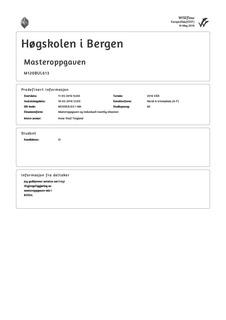| dc.contributor.author | Austrheim, Ruth Veslegard | |
| dc.date.accessioned | 2018-02-01T14:41:03Z | |
| dc.date.available | 2018-02-01T14:41:03Z | |
| dc.date.issued | 2016-05-16 | |
| dc.identifier.uri | http://hdl.handle.net/11250/2481413 | |
| dc.description | Master i barne- og ungdomslitteratur | en_GB |
| dc.description.abstract | I møte med kulturar som skiljar seg frå sin eigen er haldningar til andre land og menneske avgjerande for utfallet av dette møtet. Haldningane barn har i dette møtet blir mellom anna avgjort utifrå kva dei leser, kva dei høyrer på skulen, eller av foreldre, lærarar og andre vaksne. I lesing av atlas for barn kan ein barnelesar lære mykje nyttig om korleis menneske i andre land enn sitt eige lever, korleis landskapa ser ut og kva som er viktige næringsressursar. Men inneheld atlasa til dømes stereotypiske førestillingar om andre kulturarar kan dette påverke lesaren sine haldningar og oppfatningar. Oppgåva diskuterer om det blir fremja stereotypiske førestillingar om India gjennom atlas for barn-og unge og om India blir framstilt som ein del av Orienten. Då atlasa består av illustrasjonar, bilete og verbal tekst undersøker eg også i kva grad atlasa fremjar ein fagleg sanningsverdi. Orienten er eit fagomgrep som blir nytta om land i Austen og menneska derifrå. Då stereotypiar ofte oppstår om andre grupper enn ”si eigen” vil det vere nyttig å undersøke kva stereotypiar som oppstår om eit austleg land i atlas som er produsert i Vesten. Sanningsverdi er eit omgrep som blir nytta for mellom anna å sjå truverdigheita i bilete, illustrasjonar og verbaltekst. Difor vil det vere nyttig å sjå kor høg sanningsverdi atlasa har for å avgjere om stereotypiane som eventuelt har oppstått står fram som truverdige. For å kunne svare på desse spørsmåla har eg valt ut fire atlas som skal vere mitt materiale i denne undersøkinga. Atlasa er gitt ut mellom 1995-2014 og er alle produsert i europeiske land. Materialet består av atlasa Mitt første Atlas (1995), Barnas verdensatlas (2000), Jorden rundt (2011) og Kart for oppdagere og eventyrlystne (2014). I undersøkinga av bileta, illustrasjonane og verbalteksten i framstillingane av India i materialet fant eg at dei til ein viss grad framstilte stereotypiske førestillingar dersom ein ser framstillingane i lys av teorien eg har nytta meg av i denne oppgåva. India blir også framstilt som ein del av Orienten dersom ein ser dette i lys av korleis Orienten har blitt omtala og framstilt tidelegare i litteraturen. Sanningsverdien er alltid til stades, men truverdigheita er sterkast i tre av atlasa, då Kart for oppdagere og eventyrlystne nyttar seg av illustrasjonar som fjernar seg frå det realistiske. | en_GB |
| dc.description.abstract | When meeting with cultures that distinguish themselves from ones own, attitudes towards other countries and people are decisive for the outcome of this meeting. The attitudes of children in these meetings are affected by among other things what they have read, what they are told at school or by their parents, teachers and other adults. By reading an atlas for children they can learn many useful things about how people in other countries live. They can also learn about the landscapes and important resources in other countries. If the Atlas contains stereotypical notions about other cultures, this can influence the reader’s attitudes and perceptions. This thesis discusses whether atlases meant for children promote stereotypical notions about India and whether or not India is portrayed as part of the Orient. Since these Atlases consist of illustrations, photographs and texts, I will also be looking at how factually accurate these portrayals are. The Orient is a term used for countries in the east and their people. As stereotyping often occurs toward groups that differ from your own, it will be useful to examine what, if any of this is present in an atlas produced in the west. Truth value is a concept that is useful for, among other things, examining the credibility of images, illustrations and verbal texts in factual books. Therefore it would be helpful to examine how accurately other countries are portrayed in order to determine whether any stereotypes that have arisen stand out as credible, and have any truth value. In order to answer these questions I have chosen four atlases as the basis for this study. The Atlases were released between 1995-2014 and are all manufactured in European countries. The material consists of Mitt første Atlas (1995), Barnas verdensatlas (2000), Jorden rundt (2011) and Kart for oppdagere og eventyrlystne (2014). Upon examining this material, I found that there was certain degree of stereotypical portrayals if seen in light of the different theories I have outlined in the thesis. India is portrayed as part of the Orient similar to older literature. The truth value is always present, but the credibility is strongest in three of Atlases. Kart for oppdagere og eventyrlystne uses a lot of illustrations that appear unrealistic. | en_GB |
| dc.language.iso | nno | en_GB |
| dc.publisher | Bergen University College | en_GB |
| dc.rights | Attribution 3.0 Norway | * |
| dc.rights.uri | http://creativecommons.org/licenses/by/3.0/no/ | * |
| dc.title | Framstillingar av India i atlas for barn- og unge | en_GB |
| dc.title.alternative | Portrayals of India in Children’s Atlases | en_GB |
| dc.type | Master thesis | en_GB |

